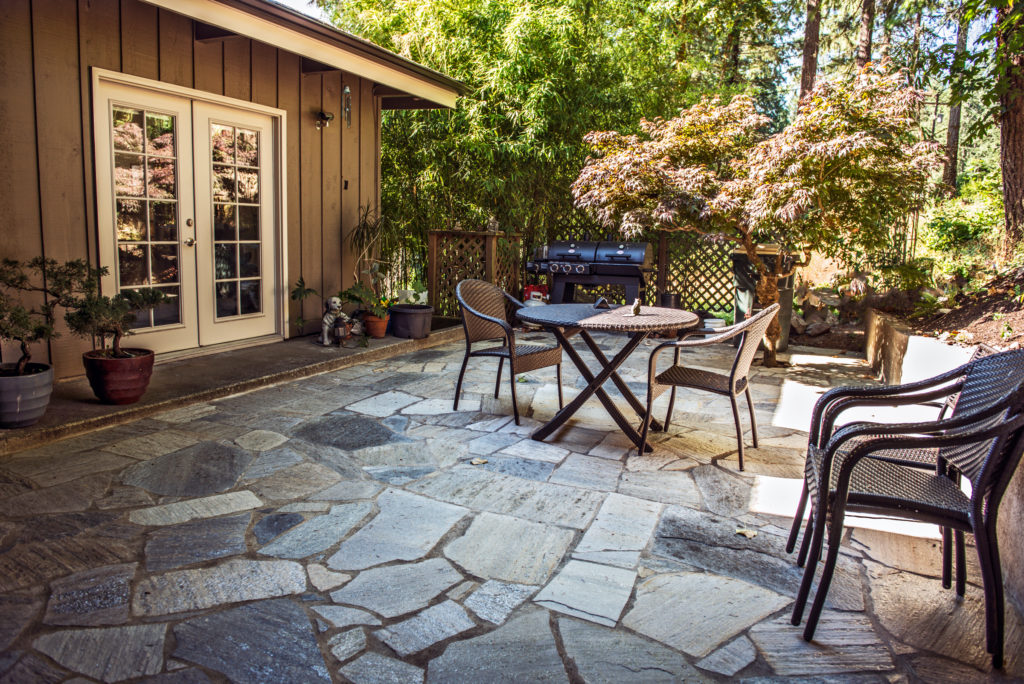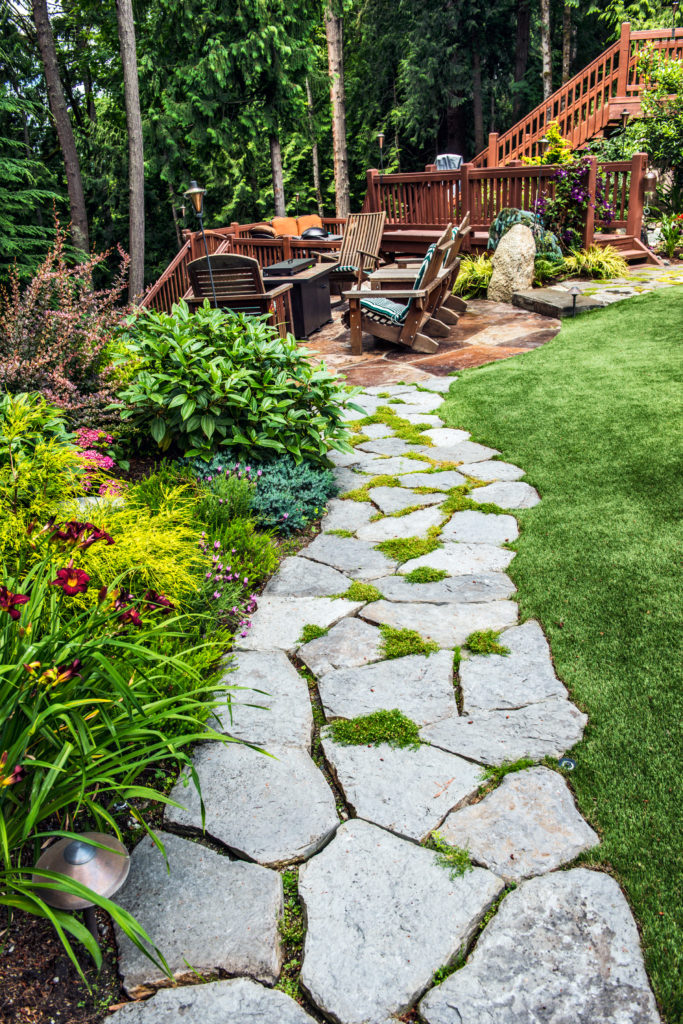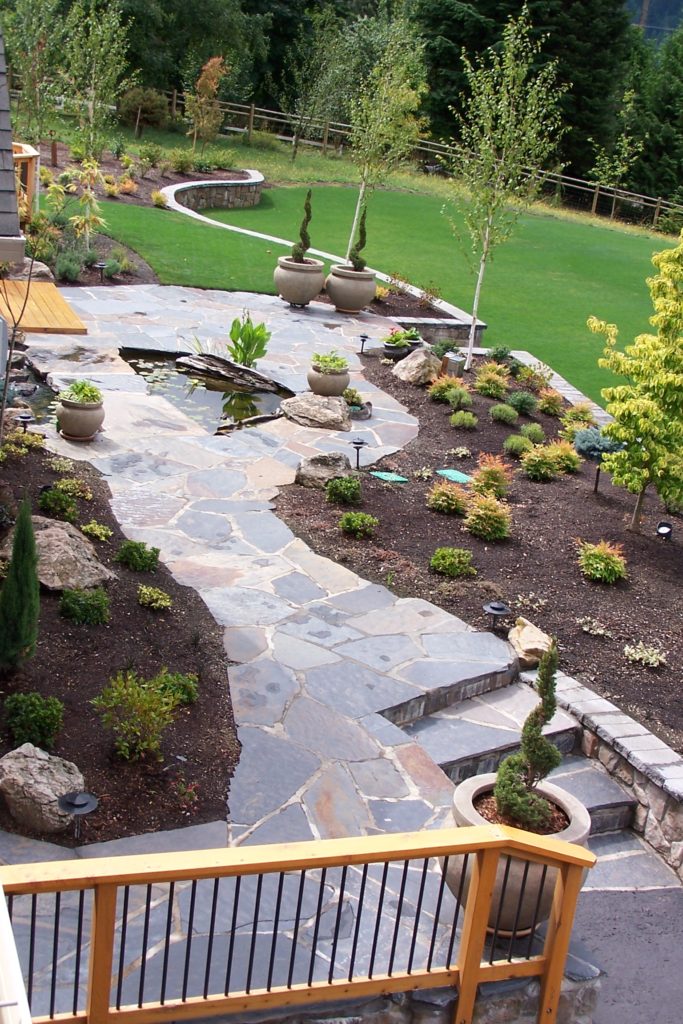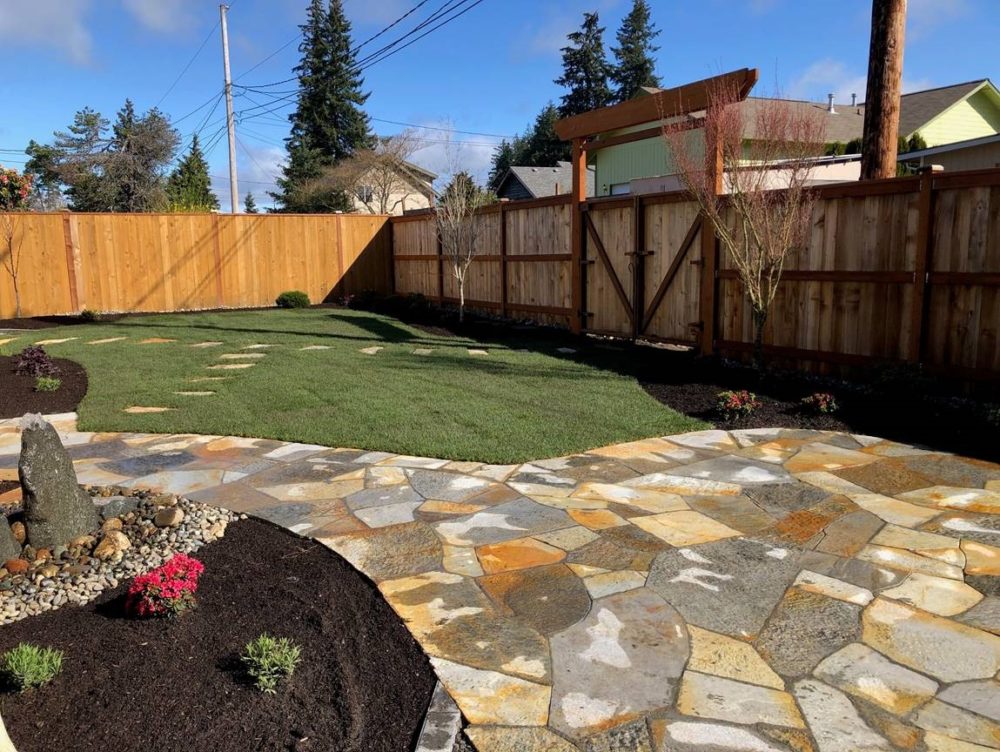Flagstone patios make a unique design statement in your outdoor living space. Because they’re 100% natural stone (one of the only all-natural materials you can use for a patio), they offer one of a kind color combinations and shapes. If you’re thinking of using them for a patio space, you will need to build some flexibility into your patterns.
LEARN MORE ABOUT OUR FLAGSTONE OPTIONS
Their uniqueness as a material is wonderful from a design aspect but does present a few challenges when it comes to working with them on a DIY project. Features like their distinct colors and shapes, and cost need to be taken into consideration before adding them to any patio project.
Here are some things homeowners need to know about using flagstone pavers to build patios, and some suggestions to make working with these beautiful stones easier.
1. Cost: Flagstones are comparable to concrete pavers when it comes to price
If you are comparing just material costs, flagstone with a thickness of 1-2 inches is generally comparable to concrete pavers or other materials. With thicker flagstone (2-3 inches) you should generally expect to pay a little more. These larger flagstones are typically used when setting them in mortar.
Additionally, installing flagstones takes more time and labor than pavers. It’s difficult to plan the layout of your flagstone patio before you see the stones you purchase, because you don’t know what exact sizes, shapes, and colors you will receive. Designing your flagstone patio is done on the fly, as each stone must be set into place and arranged according to color and size to achieve the desired fit and layout. You may find that you have to move stones around several times to get the desired look.
To help with all this moving and lifting, you should recruit volunteers or hire a contractor to do the heavy lifting. If you’re on a budget, definitely consider the volunteers first.

Project Completed by Dreamscapes
2. DIY vs Contractor: Flagstones are heavy
Flagstones are much heavier than traditional clay or concrete pavers. Usually coming in standard sizes, pavers are fairly easy to handle and haul from place to place. Flagstones can vary in size, from cobblestone size to gigantic slabs, and can weigh quite a bit.
Plan on recruiting additional manpower to help you lift the stones into place. Equipment helps, but someone needs to know how to operate it effectively and safely.
One good thing about using these heavy rocks is that they don’t have to be settled in a bed of mortar. As long as the bed and joints are filled and compacted correctly with sand or gravel, the stones will stay in place for years to come.
3. Base Install: Think outside the box for joint fillers
Several materials can be used for fillers between each stone. Flagstone mortar or grout, crushed rock or gravel base, and sand are the most common. They keep the stones from shifting and provide a level surface for furniture and décor items. Small size gravel and landscaping sand are the less expensive way to go, and they’re easier to install since you don’t have to do any mixing. You can even use colored gravel to make a singular design statement.
One note: Don’t use beach sand. Landscaping sand is coarser and won’t settle as much as time goes by.
Now, if you are looking for a softer look for your patio project, consider planting low-growing groundcover plants in the spaces between the stones. A short grass can be a wonderful accent to the natural colors of the stones. Or include short plants with small flowers to add a touch of brightness. Adding vegetation to your patio will soften the look of the stones.

Style tip: Place the flagstones farther apart and plant grass or groundcover between them. You’ll need less stones to cover the area, and you’ll still have a nice, natural-looking space.
Flagstone Patios & Walkway Project Ideas
4. DIY vs Contractor: It takes an artistic eye
The naturally occurring irregular shapes and colors of flagstones mean that putting together a patio is more like putting together a jigsaw puzzle. It takes time and an artistic eye to know what pieces should go together and how to shape the stones to match the desired area. If your patio has a lot of border areas, it can take skill and time to shape the stones to fit them correctly.
One solution is to use a less defined pattern and put more space between the stones. By letting the size and shape of the stones dictate the pattern, you will have less trimming and shaping to do. This will save you time on the installation and give your patio shape a more natural look.
Breaking stones isn’t as difficult as it may sound (breaking them where you intended is another matter!). A light hammer tap on the edge should break off pieces fairly easily. Or you can try dropping the larger stones on a hard surface and let the pieces fall apart naturally. A chisel and hammer can assist when more precise shaping is required. The key is don’t try to take off too much at one time and you should be able to shape the stones to meet your design.
5. Install: You can mix it up
There’s no rule that a flagstone patio has to be made up of only flagstones. You can save time and money by mixing flagstones with concrete or clay pavers.
Use flagstones to highlight a seating area or just the path between the seating and cooking areas. You can create a flagstone accent in the center of your patio and surround it with standard pavers, creating a unique patio design that fits your use of the space. There are infinite possibilities available by combining materials, and you get the look and beauty of the natural stone while not blowing your budget.

Putting It Together
Start with an idea. Measure the space you have to work with. Determine what types of materials you want to use and where you want them. Select your materials. Begin your layout after you have prepped the ground and the drainage rock and sand. Once you have a design you love, then “set it in stone” by pouring in joint filler and leveling the surface. Then, sit back and enjoy your new flagstone patio.
Flagstone is a wonderful, long-lasting, natural material that can be used to create one of a kind designs. No two flagstone patios will look the same. Use this distinctiveness to make your patio stand out from the crowd.


